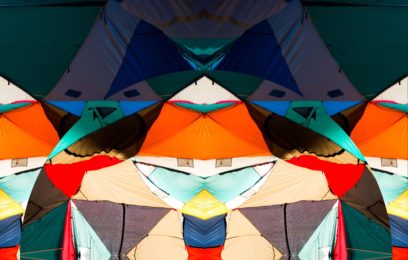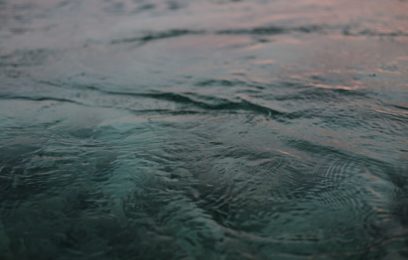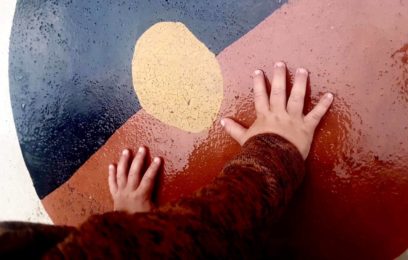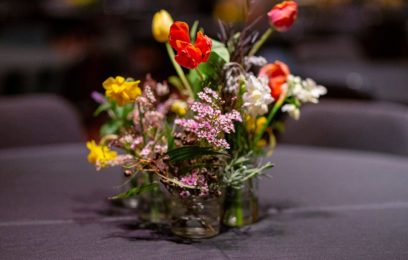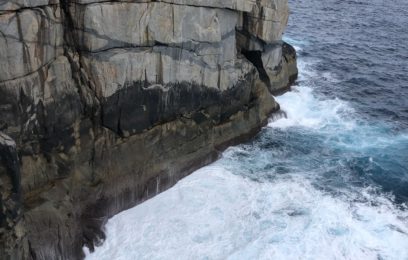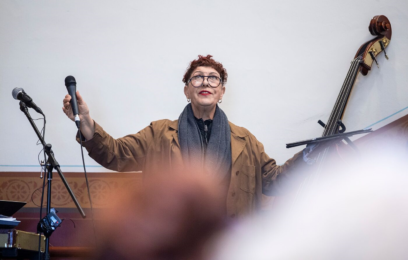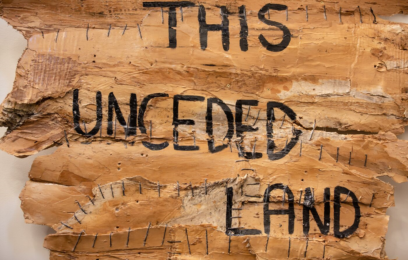Indigenous Wisdom
by Claire G. Coleman
Claire G. Coleman is a Wirlomin Noongar writer and poet, and a collaborating artist for Refuge 2019: Displacement. Claire has collaborated with artist Keg de Souza to present the North Melbourne School of Displacement, a mass installation of salvaged tents that puts learning itself under the microscope with a series of discussions that offer vital correctives to the methods of sharing knowledge that dominate our society.
In this commissioned essay, Claire reflects on the role of Indigenous wisdom in imagining new ways for the community to prepare.
Yolngu band Yothu Yindi in their song Treaty [1991] spoke of the Yolngu people’s desire for the rivers of black and white culture becoming one. It is possible to interpret their intent as Aboriginal people becoming a part of wider Australia. However, it is also possible to imagine their intent was that non-Indigenous Australia learn from the oldest living culture on Earth.
Non-Indigenous Australia should consider the possibility that the best chance the people of Australia have at surviving the coming climate apocalypse is for white people to learn from Indigenous cultures; from people who live as one with nature, who lived in the Australian environment for tens of thousands of years without destroying it.
Indigenous Australians are among the world’s greatest survivors.
In First Footprints, a book and documentary series by Scott Cain, it was established that the Aboriginal people survived the last ice age. During that time Australia was not glaciated en masse. Instead with the water locked up in glaciers and ice-caps worldwide, with the lowering of sea level and the increasing land area, Australia was locked in the greatest drought in world history.
The most inhospitable inhabited continent on Earth became even more inhospitable. No water to be had, overnight temperatures of minus 25 Celsius. And yet, in those conditions people lived, thrived and developed complex cultures.
This ice age lasted 10,000 years; it glaciated the mountains and turned 90% of the continent into desert. A massive extinction event wiped out the mega-fauna on which Indigenous populations would have relied for food. People survived, are still here now, because of adaptability that would ensure our survival through any future apocalypse.
Even during that time, that glacial maximum, when there was little water for thousands of years, Aboriginal people lived here. We have always lived here, in the harshest environment on Earth, even when in pre-history it became even more difficult to live here. We have always lived here on this continent despite a concerted attempt, starting 231 years ago, to destroy our cultures and render us extinct.
Aboriginal Australians are the world’s greatest survivors; we lived, thrived even, on the driest inhabited continent on Earth; even through pre-historical times when the inhospitableness of the continent became unimaginably worse. We survived one of the most brutal invasions and colonisation events in history; and one of the world’s most concerted and prolonged efforts at genocide. Being arguably the most resilient community on Earth it is not a stretch to conclude that our survival techniques and unique timeless culture could teach others to survive the coming climate apocalypse.
It would be tempting to imagine that the only skills and cultural changes needed would be to learn environmentally friendly farming techniques and ways to collect and conserve water. However, without major cultural changes these practical skills would be useless. There are major differences between the Indigenous cultures of Australia when compared to white Australia. The first of these could perhaps be called “non-greed”, looking after family and even strangers and never taking more than is needed.
Another cultural aspect that could save the world is the consideration that the landscape, environment and everything that lives on is a part of identity, a loved member of the family and something to protect. The environment in which someone lives is not a separate thing, to Aboriginal people, but a part of the self. This makes it impossible to exploit the environment; because to harm the environment is to harm oneself.
This is in stark contrast to the Christian concept of land, one to which non-Indigenous Australian culture keeps fidelity to even when the Christian religion itself is waning, which identifies land as something to use, even exploit, for the good of one’s self and family. The Western Christian concept of land usage considers the environment to be a gift from god, it only exists so the pinnacle of creation, humans, have somewhere to live and something to exploit. In the Christian Bible in Genesis 1:28 it said ‘God blessed them, and God said to them, “Be fruitful and multiply, and fill the earth and subdue it; and have dominion over the fish of the sea and over the birds of the air and over every living thing that moves upon the earth”.’
Lynn White, Jr in The Historical Causes of Our Ecologic Crisis [Science, Volume 155, Number 3767, 1967] wrote: “Especially in its Western form, Christianity is the most anthropocentric religion the world has seen.” This anthropocentrism is at odds with animistic beliefs that existed before Christianity and could be seen as a root cause of our ecological woes.
Aboriginal cultural ways instead see humanity as part of nature; our purpose is not to exploit it but rather to protect and aid it. When generosity towards everybody is extended to everything by the Indigenous beliefs in interconnectedness generosity is extended to landscape, and to the plants and animals within that landscape.
More than ever before information regarding Indigenous land management and the culture that enabled it is readily available. Dark Emu by Bruce Pascoe digs deeply into the whitefellas own archive, into history and explorers diaries, to extract the nuggets of fact that Australian culture ignores. What he has discovered is that the Australian historiographical interpretations and understandings of Indigenous culture, civilisation and land use have erased the proof in the history of sedentary agricultural societies that existed for tens of thousands of years before the British invasion of Australia.
In The Biggest Estate On Earth by historian Bill Gammage, the evidence in history and archaeology is examined to establish that the entire Australian continent was managed as a single estate by a civilisation that was culturally adapted to provide plenty for all. The only way this was possible, Gammage argues, is if any family group or clan could be certain that the neighbours would manage their land for the good of all including distant people they have never met. Selfish, destructive, behaviour such as the collecting and storing of water at the expense of people downstream would have been unthinkable.
Non-humans also were part of this system of systems. Animals, plants, the land itself had value; not a value to humans as much as a spiritual value or a value to themselves. Consider that often the best habitat for an animal, a kangaroo for example, was protected, sacred, hunting that animal in those areas was taboo, damaging that place was unthinkable. In that way an animal could never be hunted into extinction; they had refuges, their best habitats, in which they would always survive and from which they would always return.
This concept of a place that is protected and nurtured for it’s own sake not for any human use has long been difficult for people of European descent to understand. I am not talking national parks, which are protected for human recreation, not for the good of the environment itself, I am talking about something more like biosphere reserves, where the landscape and the ecology is protected for the good of that landscape and ecology. Biosphere reserves, however, still allow some human utilisation of the “resources” in those places.
Marine parks, where fishing is not allowed, improve the fishing around them because the fish can breed, grow, survive in those places and spread into surrounding areas. However, rather than understanding this, commercial and recreational fishers, rail against the gazetting of new marine parks which will rather than taking away opportunities will improve fishing in areas around them. This is not selfishness, this is foolishness; even enlightened self-interest would lead them to demand more marine parks.
Aboriginal wisdom would state that all animals need their own sacred places where they can thrive. All animals, not just the charismatic ones. The importance is placed on interconnectedness, between people; family connections that can exist over vast distances. This interconnectedness extended to more distant family; Dreamtime ancestors, animals, plants, places themselves were all family. This cultural lore has enabled people to not just survive but even thrive through the worst of disasters.
These interconnections, the culture, the methodologies were carried and transmitted along songlines by trade and by the communication of stories.
It was not the survival skills, it was not an ability to survive particular environments that ensured the survival of Aboriginal cultures and peoples during environmental and socio-political upheavals. Rather it was a sort of adaptive wisdom, a way of looking at the environment, people and resources that ensured survival. It was interconnectedness and an unselfish, connected, way of examining the world that fortified Indigenous people against disaster.
Aboriginal people, rather than being the unchanging stone-age culture non-Indigenous people have been taught to consider us to be, are a powerfully adaptable people. It has only taken us 231 years to have respected members in every academic environment and industry in Australia. Yet, despite our infiltration into the entirety of modern Australian life, we have maintained our connection to culture and to each other.
Western culture, rather than practising interconnectedness, is focussed on the celebration of the individual at the expense of the collective. An expansion of the self to include family, an expansion of family to include more people and the land itself would make harming the environment unthinkable; would make allowing other people or rivers to die for short-term gain unthinkable; would save lives and protect the environment.
Indigenous people mean no harm to non-Indigenous people; we have throughout history, on countless occasions, worked to save and protect people from outside of our communities. We have survived upheavals that other people can barely imagine. Perhaps it is our thinking, our unique cultures that have made this possible. If our ways can aid the wider community to end the destruction of our beloved lands, if we can help the wider community survive the coming climate apocalypse, perhaps our ways should be protected.
Claire G. Coleman is a Wirlomin Noongar woman whose ancestral country is in the South Coast of Western Australia. Her debut novel Terra Nullius, published in Australia and the USA, written on a second-hand iPad in a caravan, has won the Norma K. Hemming Award and a black&write! Writing Fellowship and was shortlisted for The Stella Prize and an Aurealis Award. She has written essays, short fiction, reportage, opinion, criticism and poetry for publication on multiple national and international platforms and is a popular speaker and storyteller. The Old Lie is her second novel. More information can be found here.
Refuge drops us in the hot zone of different climate-related disasters: flood, heat, pandemic and displacement, this five-year project offers new ways to rally as a community and prepare for climatic events. Refuge is developed and presented by Arts House, a key program of the City of Melbourne, in collaboration with a range of emergency services and community partners including Red Cross, SES, Emergency Management Victoria, University of Melbourne and many others. Find out more here.
